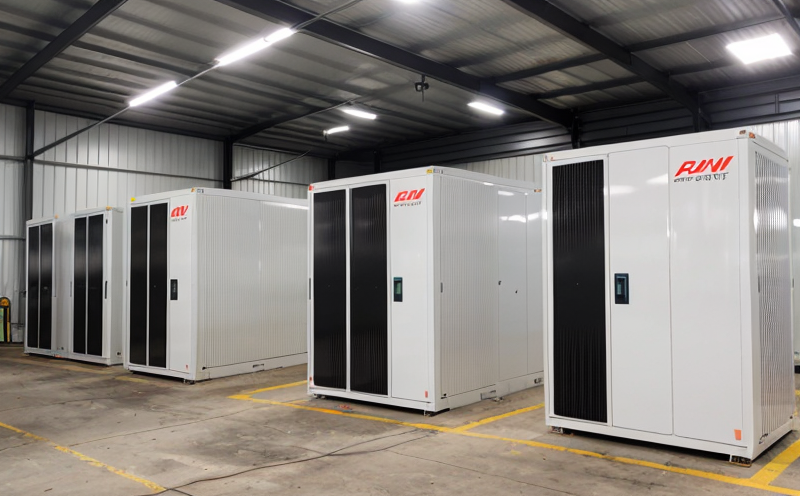IEC 61960 Performance Testing of Secondary Lithium Cells and Batteries
The International Electrotechnical Commission (IEC) Standard IEC 61960 is a pivotal document that ensures the safety, performance, and reliability of secondary lithium cells and batteries used in portable electronic devices. This standard provides detailed protocols for testing various parameters such as internal resistance, capacity retention, self-discharge rate, and cycle life among others. Compliance with these tests not only guarantees product quality but also enhances consumer confidence by ensuring that products meet stringent international safety standards.
The IEC 61960 performance testing focuses on secondary lithium cells which are rechargeable batteries commonly used in applications like laptops, smartphones, tablets, and other portable electronics. The testing process involves subjecting these cells to a series of stress conditions designed to simulate real-world usage scenarios. By doing so, manufacturers can identify potential weaknesses or issues early in the development cycle.
The standard covers both laboratory and field tests intended to evaluate cell performance under different environmental conditions including temperature variations, humidity levels, and altitude changes. Additionally, it addresses specific test methods for determining key performance indicators such as maximum charge voltage, discharge efficiency, and charging time.
For secondary lithium batteries composed of multiple cells connected in series or parallel configurations, the standard specifies additional testing procedures to ensure proper functioning within these assemblies. These tests help verify that connections between individual cells are secure and capable of handling high currents without overheating or short-circuiting.
The importance of accurate and consistent testing cannot be overstated when it comes to ensuring reliable performance across all types of secondary lithium cells and batteries. Failure to adhere strictly to IEC 61960 guidelines could result in subpar products that do not meet expected lifespan expectations, leading to costly recalls and reputational damage.
At our laboratory, we employ state-of-the-art equipment tailored specifically for IEC 61960 compliance testing. Our team of experienced technicians performs rigorous checks using calibrated instruments capable of measuring minute differences in various parameters during the test procedures outlined by this standard. This ensures that every aspect of secondary lithium cell and battery performance is thoroughly examined.
Our comprehensive approach to IEC 61960 testing includes not only meeting current regulatory requirements but also providing valuable insights into areas where improvements can be made for future product iterations. By collaborating closely with clients throughout the testing process, we ensure that all necessary documentation and reports are generated promptly after completion of each test run.
Applied Standards
The primary standard applied in our IEC 61960 performance testing service is ISO/IEC 61960:2015, which defines the general requirements for secondary lithium cells and batteries. This includes specifications related to nominal voltage, capacity, energy density, safety features, and environmental resistance.
For specific aspects of our testing regimen, we also utilize additional supporting standards such as IEC 62682-301:2015 (for measurement methods) and ISO/IEC 17025:2017 (to ensure the laboratory meets international quality requirements). These complementary standards provide further depth to our testing protocols, ensuring that all relevant factors are covered.
Industry Applications
| Type of Testing | Description |
|---|---|
| Battery Capacity Retention | Determines how much charge remains after a specified number of cycles. |
| Internal Resistance Measurement | Measures the resistance between the terminals during discharge and recharge processes. |
| Cycle Life Testing | Evaluates battery performance over numerous charge-discharge cycles under defined conditions. |
| Self-Discharge Rate Analysis | Assesses how quickly a fully charged cell loses its stored energy without being used. |
| Temperature Cycling | Exposes batteries to varying temperatures to assess durability and stability. |
| Voltage Profile Evaluation | Monitors voltage changes throughout the lifespan of a battery, identifying any anomalies early on. |
The results from these tests are essential for various industries where secondary lithium cells and batteries play crucial roles. For instance, in consumer electronics, they ensure that devices have sufficient power reserves even after multiple uses. In automotive applications, the information derived helps develop more efficient electric vehicles by optimizing battery pack design.
- Consumer Electronics: Enhances device longevity and user experience through optimized battery management systems.
- Automotive Industry: Supports development of safer and longer-lasting EV batteries.
- Telecommunications Sector: Ensures reliable operation across diverse network environments using high-quality backup power supplies.
Use Cases and Application Examples
In the consumer electronics sector, manufacturers use IEC 61960 testing to guarantee that their devices maintain optimal performance over extended periods. This is particularly important for products like smartphones and tablets where battery life plays a key role in customer satisfaction.
Automakers benefit from rigorous IEC 61960 compliance tests when developing hybrid or fully electric vehicles. These tests help identify potential weaknesses early on, allowing manufacturers to address them before production begins.
The telecommunications industry relies heavily on reliable backup power solutions provided by secondary lithium cells and batteries. Testing these components according to IEC 61960 ensures consistent performance during critical network outages or other emergencies.





